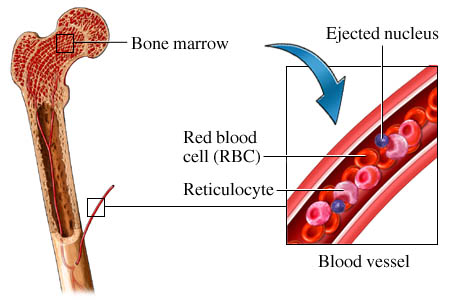Reticulocyte definition and count

What is Reticulocyte and Definition
An ERYTHROCYTE (red BLOOD cell) that enters the blood’s circulation from the BONE MARROW just before it has reached maturity. Reticulocytes are somewhat larger than erythrocytes and normally make up about 1 percent of the erythrocytes in circulation. A reticulocyte matures into an erythrocyte after being in circulation for about a day. Reticulocytes are still continuing to synthesize (make) HEMOGLOBIN, so contain somewhat less hemoglobin than mature erythrocytes.
Reticulocyte count
An increased number of reticulocytes in circulation indicates the BONE marrow is producing erythrocytes more rapidly than normal. Accelerated erythropoiesis may suggest various underlying causes, such as undetected internal bleeding, hemolytic ANEMIA, and extended exposure to high altitude (which increases the body’s need for oxygen). The reticulocyte count also rises in PREGNANCY and with some medications such as NONSTEROIDAL ANTI-INFLAMMATORY DRUGS (NSAIDS), levodopa taken to treat PARKINSON’S DISEASE, and sulfonamide ANTIBIOTIC MEDICATIONS.
Low Reticulocyte Count
A decreased count of reticulocytes in circulation suggests chronic INFECTION, exposure to radiation, aplastic anemia, or iron-deficiency anemia. The reticulocyte count also may drop with CHEMOTHERAPY, the antibiotic chloramphenicol, and the immunosuppressant medication azathioprine typically taken after ORGAN TRANSPLANTATION to prevent organ rejection or severe RHEUMATOID ARTHRITIS.
For further discussion of reticulocytes within the context of blood and lymph structure and function please see the overview section “The Blood and Lymph.”
See also CELL STRUCTURE AND FUNCTION; HEMATOPOIESIS; IMMUNOSUPPRESSIVE THERAPY.
Open discussion on the topic Reticulocyte definition and count
Similar interests
- Nuovi Casino
- Casinos Not On Gamstop
- UK Casinos Not On Gamstop
- Casinos Not On Gamstop
- UK Casinos Not On Gamstop
- Casino Non Aams Italia
- Slot Sites Not On Gamstop
- Meilleur Casino En Ligne
- Non Gamstop Casino Sites UK
- Meilleur Casino En Ligne
- Casino En Ligne France
- Best Non Gamstop Casinos
- Casinos Not On Gamstop
- UK Casino Not On Gamstop
- Casinos Not Signed Up To Gamstop
- Best Slot Sites UK
- Non Gamstop Casino Sites UK
- Online Casinos Nederland